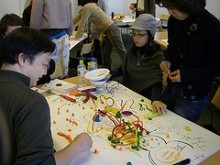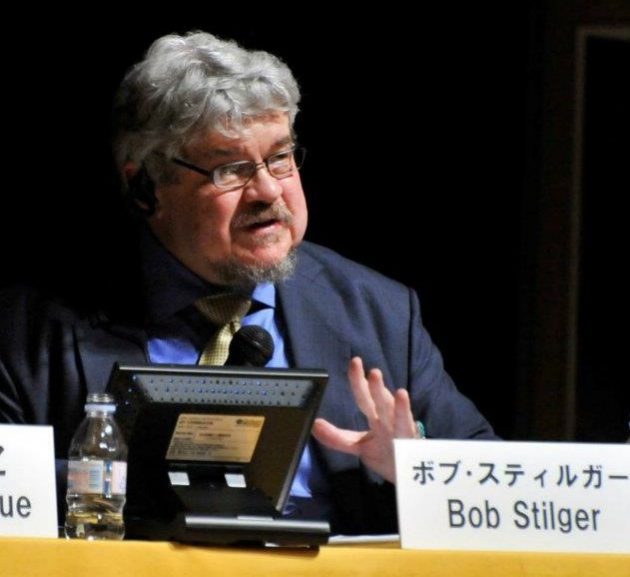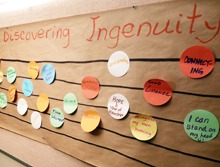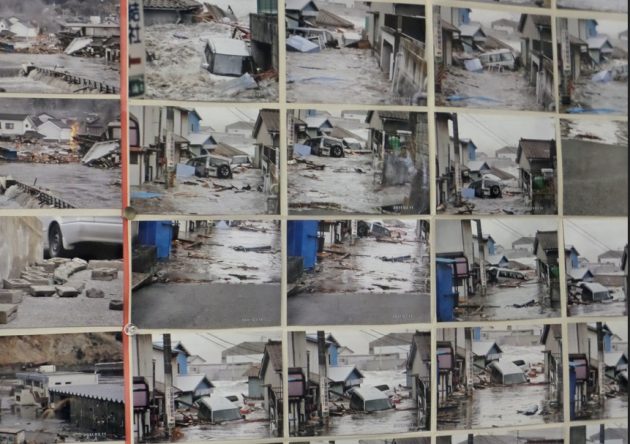
Bob Stilger is a professor and facilitator who has been working with communities and pioneering leaders across the world for over 35 years. Having maintained a strong relationship with Japan since first coming to the country in his 20’s, Stilger has been actively involved in creating spaces for people in Tohoku to gather and formulate new futures following the devastating earthquake and tsunami that transformed their lives. Lucinda Cowing and Mizuho Toyoshima met with him in March 2013 in Kyoto.

It was the second anniversary of the Tohoku Disaster recently. What were you doing at that time?
A week ago, Sunday, we had a delightful small, reflective dialogue at a place called Rensho-an in the town of Tamura near Koriyama, Fukushima. There was a group of maybe twenty people, most of them from the Tamura area, a few from other parts of Fukushima and elsewhere. Rensho-an is a beautiful space built by one Watanabe Shumei, a prolific artist and a man who enjoyed life. Over the course of Watanabe’s life — he died 7 years ago — it was a retreat space for people who knew of Watanabe’s work to come and spend time with him and Jinko, his wife. Jinko is now turning Rensho-an into a “learning center for life.” So, people came together just to be with each other, and to look back over their journeys these past few years.
After that dialog, I hosted a gathering of leadership from the Transition Town Movement in Japan and others from our Tohoku Futures Network. We spent two days to exploring what has transitioned in learning that might be useful in Tohoku at this important time.
After my meetings in Fukushima, I went to Otsuchi for the last of a series of four Future Sessions meetings, where people had come together to discuss what they could do themselves to make Otsuchi a better place to live. Some people in Otsuchi complain there that there are no longer any jobs; almost all fishing boats were destroyed in the tsunami. But those who attended the meeting are taking a different perspective and saying, “What do we have and how can we use it?” One of the ideas that they are working on is to make use of a local network of underground streams known to be incredibly pure and fresh, which enabled them in the past to cultivate wasabi, and also produce tofu. Now one idea is to recreate an industry centering on wasabi and tofu that last existed in the 1800’s, and tourism as well.
Are you seeing progress in Tohoku?
Yes. But one thing that has come up in many conversations is that conditions in each part of Tohoku are extraordinarily different. It is evident the coastal areas of Miyagi and Iwate have more in common with each other than they do with more inland areas of those same prefectures. When you visit Sendai, which is inland Miyagi, you find most people just want to get back to the old normal, whether or not they liked the old normal. That is not what is going on in the coastal areas. There is a sense that 3/11 opened up a new future, now it is a matter of finding out what it is and how to we create it.
In Fukushima, the statistics I’ve heard are that 1/3 of the population would leave if they could, while another 1/3 are still reeling, depressed, frozen in place to the point of not even considering leaving. But then there is this other third, some of whom I get to work with, who are making a powerful declaration: “this is our home. The past is gone and the future is what we make together.” There’s incredible focus and energy there.
I get annoyed when I see news articles or even receive e-mails from the US that exclaim, “Oh no! Nuclear debris is washing up on our shores! What are we going to do?” This is a far cry from what I hear from people inside Fukushima itself about radiation. These people live with radiation every day, they know that it is going to be present for the rest of their lives if they choose to continue to live in Fukushima. Some of the things they point out, for example, are that the epidemiological studies on Hiroshima and Nagasaki victims are inconclusive. We don’t know why some people become ill and others don’t. From the point of view of Fukushima people, this means that they must do everything in our power to live as healthily as they can in these circumstances. Food, exercise, lifestyle and habits are all part of the regular discourse there.
There has been a fair amount of research that people are paying attention to there on how critical physical play is for children and their development. So creating new, safe environments for children to play has become a priority as part of efforts to ensure their future in Fukushima. By comparison, kids in Tokyo will sit in front of their TV sets, playing video games, and undertake very little physical exercise. Who is going to end up being healthier? I’m going to bet on the kids from Fukushima.
So how are they creating safe spaces for kids to play?
One is to create indoor playing fields. I happened to see one on TV the other day, which even had a beach! Taking kids on play holidays to parts of the provinces further inland is another. New camps and residential recreation programs are being created as well
 It seems this disaster has given rise to spontaneous creativity. This seems to be a natural human reaction in difficult situations. Of course there are many concerns too, such as the radiation…
It seems this disaster has given rise to spontaneous creativity. This seems to be a natural human reaction in difficult situations. Of course there are many concerns too, such as the radiation…This man is resigned to this fact, that such a disaster will happen again?
Actually, it wasn’t until he said it that I accepted it as true as well. It will not stop. We will still pursue the myth that nuclear power is cheap and reliable.
It was deeply touching that they had such awareness and consciousness, especially considering how crazy everything was in August 2011. Hakuzaki-san is also developing extensive plans around solar-supported aquaponics and hydroponics.[1] I’ve witnessed a lot of prototyping work occurring in the areas of food, childcare, permaculture and energy systems. There is a great urge to work on natural energies, and many are trying to build networks of individuals who want to develop small scale solar and wind systems.
So it’s not just innovation that’s occurring, but a kind of decentralization as well.
Right. But one of the difficulties right now is that much of the creative work across the whole region is being done a bit in isolation and without enough shared lerning. I think that’s less true for work on children’s play work than the other areas. In general, people are tackling these issues on their own, and don’t make the time to connect and learn with others who have the experience and knowledge.
And that’s where you come in?
Yes, that’s part of our work as well: to make it easier for people to connect with and learn from each other, and take their practice to the next level.
How can we open up a creative space in such a situation as the one we find in Tohoku? There is no model: it is unprecedented. You are talking about the necessity of finding a new way.
This is talked about more in Japan than any other culture I’ve been in. It still amazes me that when I’m working with a random group of people here they will talk about “ba-zukuri” — creating a space between us. Anytime we build a space based on the principles of trust, respect and generosity at its core, we create the conditions for what I call a “collective magic.” When we come together in this way, we start to develop our creativity. This could be spending an afternoon of dance, and learning about what relevance dance could have in our current situation, or using it as a way to understand our bodies and our responses more deeply.
I often bring play-doh (children’s modeling clay) to our groups in Japan and ask them to create models of the system they’re in. The first response is of course, “I haven’t touched play-doh since I was in kindergarten,” but after a few hours it becomes “This is amazing! I hadn’t been able to find a way to express these things before.” Creating this kind of ba, accompanied by powerful questions, prove to be key in releasing creativity and engaging with it too.
It is also critical to remember that when we try something new it usually doesn’t work at first. A good example is the story of Wangari Maathai, the woman from Kenya who won the Nobel Peace Prize in 2004, Most remember her for having planted one million trees, which is awe-inspiring. But most don’t realize that the five of the first seven trees she planted died. Failing at something new, especially that is normally outside of our competency range, is perfectly normal. We learn from that experience and move forward. When we’re working with transformation and emergence, plans that we enact in unpredictable circumstances we have no choice but to try, adjust and try again. All you need to do is find the first step forward, and after that make a new path by walking. In fact, that’s the way anything significant and new has been created.

I imagine you have encountered emotions like anger and grief that have interfered with this “collective magic”, in other words, people who are unwilling to accept your ideas. How do you deal with this?
I am no longer interested in trying to convince anyone of anything. Based on my philosophy and experience, it is a waste of time. I am more interested in working with the power of invitation. There are enough people around who are eager to create something new and different. If we concentrate on supporting them, their work eventually gives off a kind of aroma, that grabs the attention of others around them who think, “they look like they’re having fun, they’re doing good things, I’ll go join them!” Organizations like Kyoto Journal play a critical role as a bridge between the old and new paradigm, because through the articles you publish, you make it easier for people to enter a system that seems foreign to them.
This is different to the development model of the past 60 years, based on outsiders coming in to help someone else. Another example would be of the Zapatistas during the revolution in Mexico in the 1990’s. When the Zapatistas came out of the jungle in a desperate last resort to secure a future for their children, they knew they would die but hoped that enough attention would be created to cause a shift, though they didn’t know what. They were surprised to find they weren’t killed, and it became a media sensation, drawing many people, mostly young, to beat a path to Chiapas offering assistance. The Zapatistas response was, “If you have come here to help us, please go home. If you are here because the issues you are facing are the same as ours, please join us. We have much work to do together.”
Your basic principles of community building and social change can be applied in almost any community in the world. What are the strengths and weaknesses of Japanese culture in this approach to social change?
Three years ago I was very surprised to find myself doing work with businesses in Tokyo on things that were really interesting to me. Thousands of years ago, Japan’s villages were isolated and the economy centered around rice cultivation, which meant there was no distinction between business and the community. I realized that even today businesses are still a part of the community in many ways. Take Fujitsu, which a couple of years ago started asking, “What can we do for people with dementia?” This is not a question I have ever found companies in the US asking. Fujitsu will ultimately profit from this venture, but their intiial question was not about how to make money, but how to be of service to the community. Similarly, Honda has been considering how to help older people who can no longer drive. Japanese companies are still a part of community rather than apart from community.
There is a growing discontent over globalization, and in Japanese businesses much of this stems from not feeling connected to the people who buy and use their goods and services. Many are asking, “How do we relocalize?” This is one example of collective culture, in which the good and relationships of the whole takes precedence over that of the individual. The negative side of that is of course the idea that “the nail that sticks out gets pounded down” and feelings of “I don’t want to stand out.” That said, I have noticed over the past three years that the challenge of individuating from a collective culture is smaller than that of creating a collective out of an individualistic culture. 3/11 was a kick in the ass for people to stand up for what they believe, but they are doing this while staying connected to the collective at the same time. I think this is the energy we need all over the world: the capacity to differentiate while staying connected.
Given that much attention is focused on the negative aspects of Japanese collective culture, this makes me feel differently about it.
Recently I did a retreat for a group of about 25 people connected to a Tokyo-based NPO called ETIC (Enterprise Training for Innovative Communities). The leader, Yamauchi-san, set up a Disaster Recovery Leadership Development Project for young people to assist communities in Tohoku for 3-12 months and funding their living subsidies. Some of these young people were at this retreat. Six of them were women, and my wife suggested creating a space where they could speak privately. These women were saying how they’d noticed the men wanted women on their teams, because it changes the relational field and makes it more cooperative. I just love that this insight has come about. Many things are shifting in Tohoku.
To go into more personal territory now: where do you think you would be had 3/11 not happened?
I have no idea. I’ve led a somewhat unusual life whereby I’ve followed wherever I’m called to be. My showing up to Japan in 1970 was not part of a plan, but because a door opened and I chose to walk through it — I’m glad I did.
In my logical mind, the way I’ve been living the past few years makes no sense: why on earth is a gaijin with limited Japanese language capacity spending so much time working in Japan and Tohoku? I never felt this kind of call when Katrina happened; I didn’t feel a strong urge to go to New Orleans. Even though I was in the US at the time of 3/11, I was absolutely clear that I wanted to support people in Tohoku and help them create a future they want rather than the one that the Japanese government would create.
If the Monbusho (Ministry of Education) asked you to come up with a syllabus that would be taught to all schoolchildren in Japan, what would be three things you would teach?
The first is to teach them how to listen to themselves. The second, how to listen to each other. Thirdly, how to listen to the world around them.
A Kyoto friend, Jeff Berglund, told me that we talk about high context and low context culture but most people don’t really knows what those terms mean. Jeff unpacks the terms: he believes the primary cultural competence for communication in a high context culture like Japan is listening. US is a low context culture, so the primary competence is speaking, and that’s why we often misunderstand each other so much of the time. I think this cultural competence for listening in Japan has been eroding – we need to bring it forward now.
[1] Aquaponics refers to symbiotic farming methods which combine aquaculture and hydroponics (cultivating plants in water, without soil). In a recirculating system, the nutrients in the waste produced by farmed fish (or other aquatic life) are supplied to the plants grown hydroponically, which in turn purify the water.
